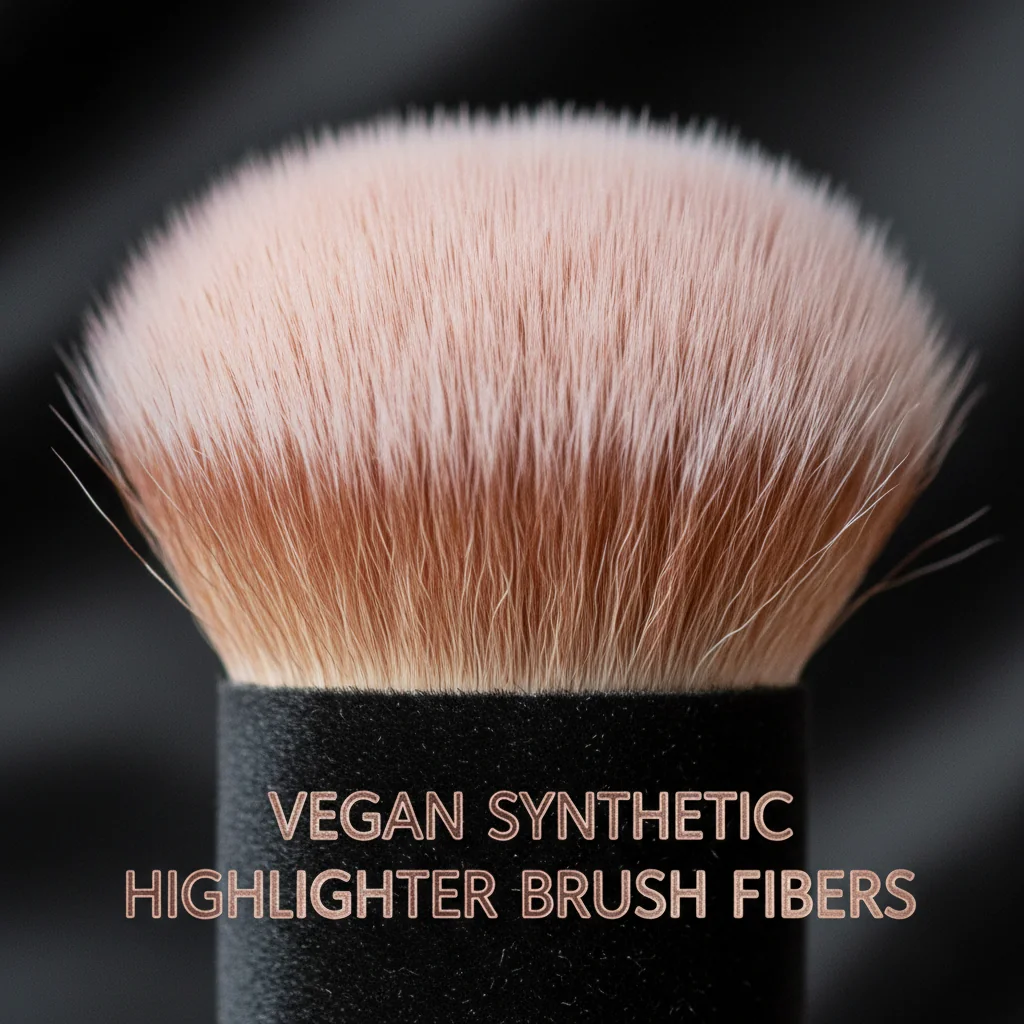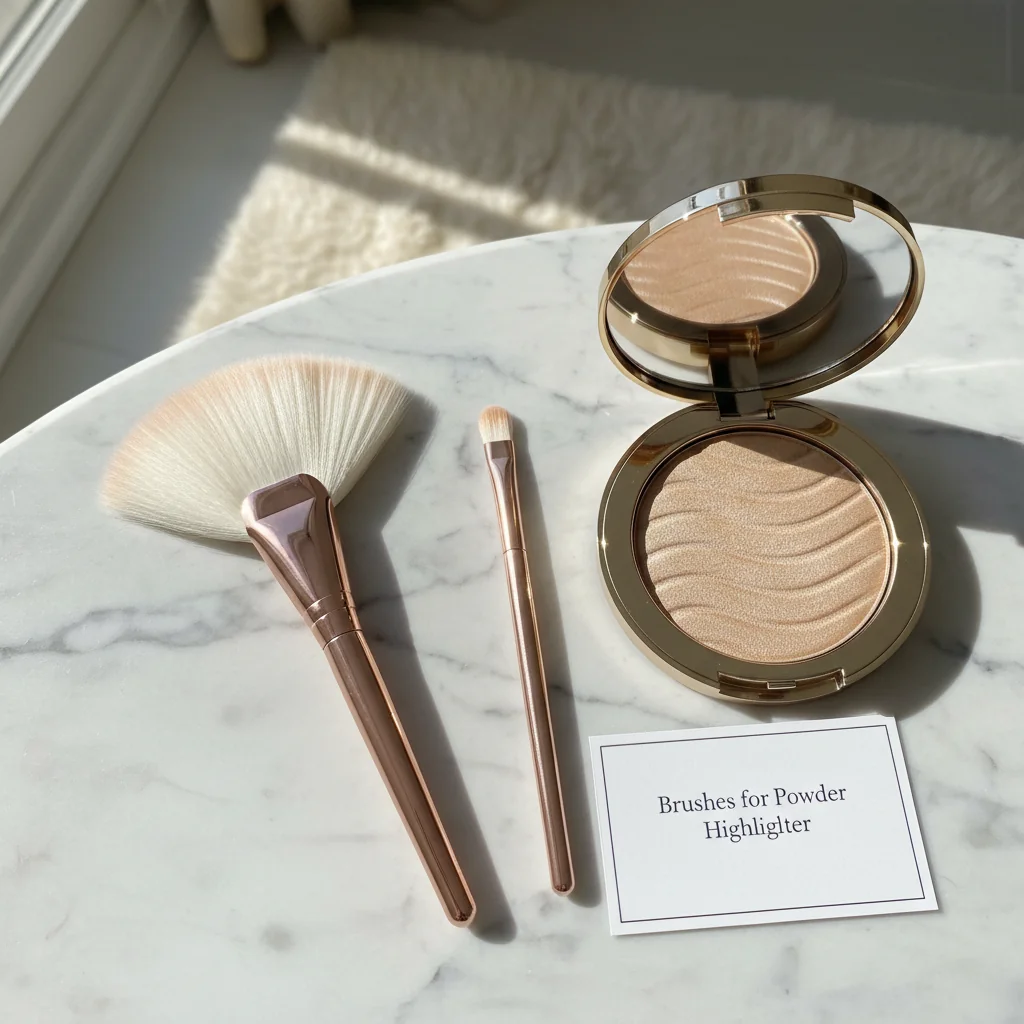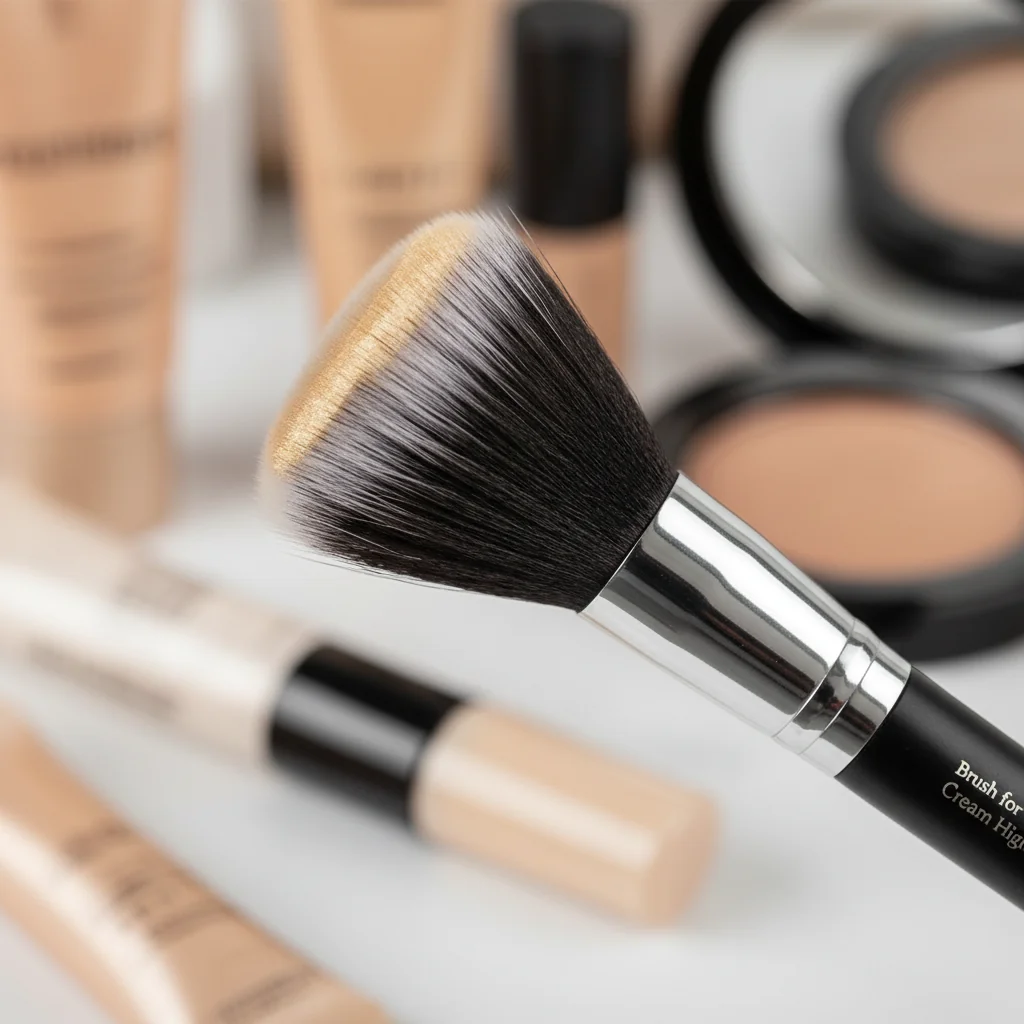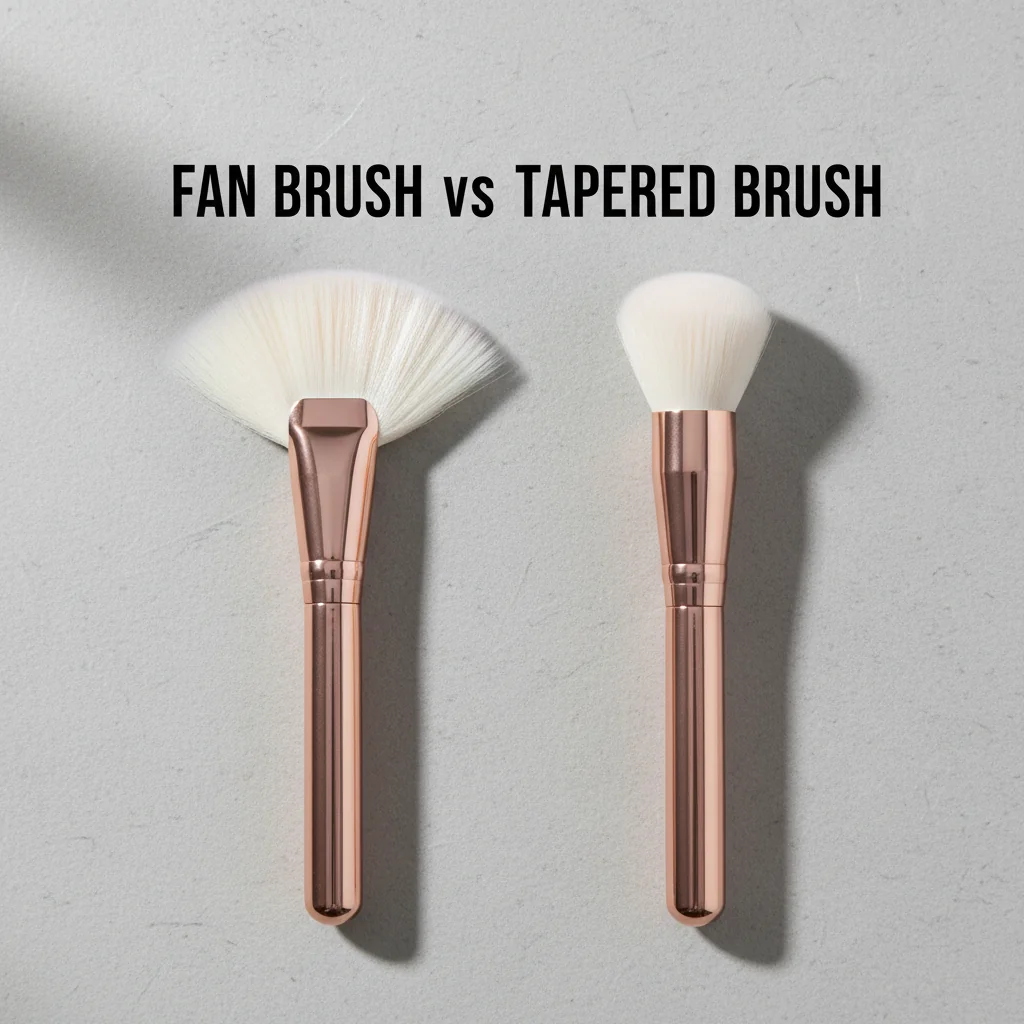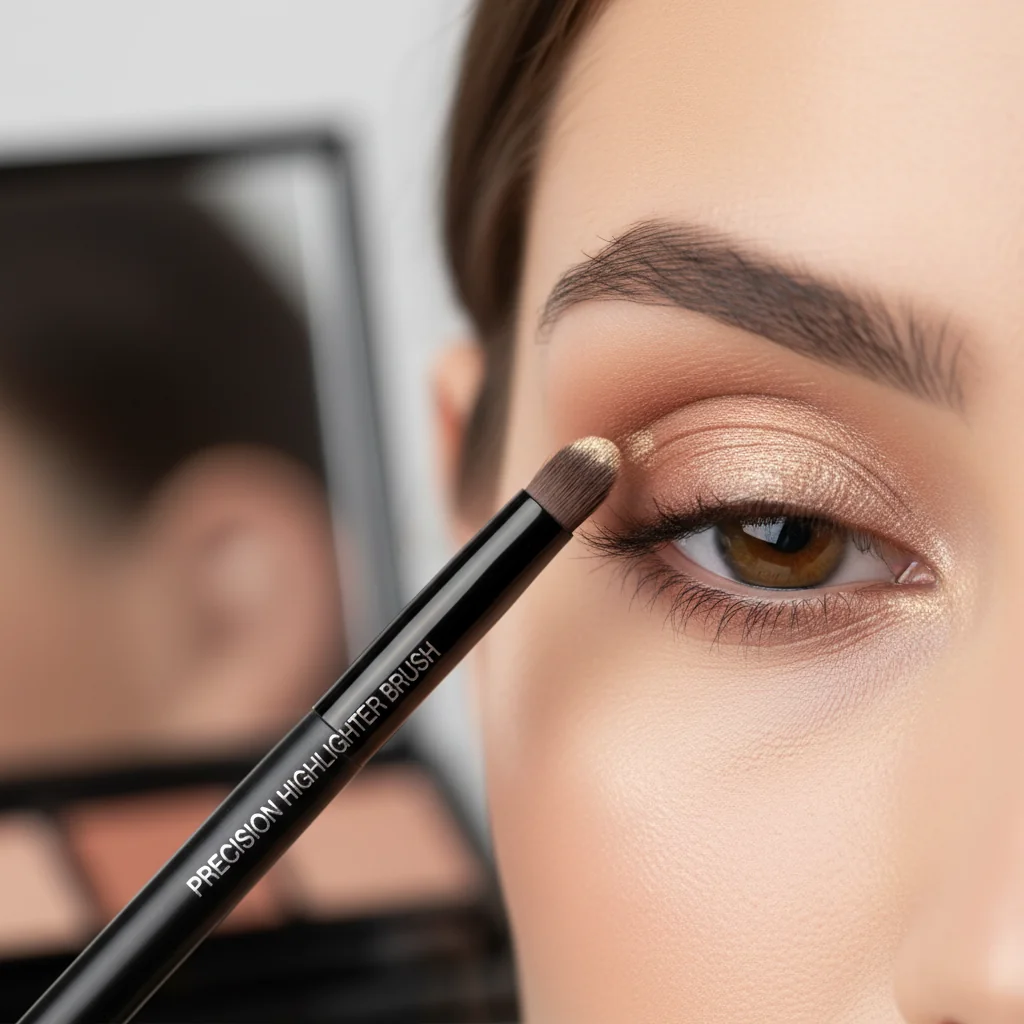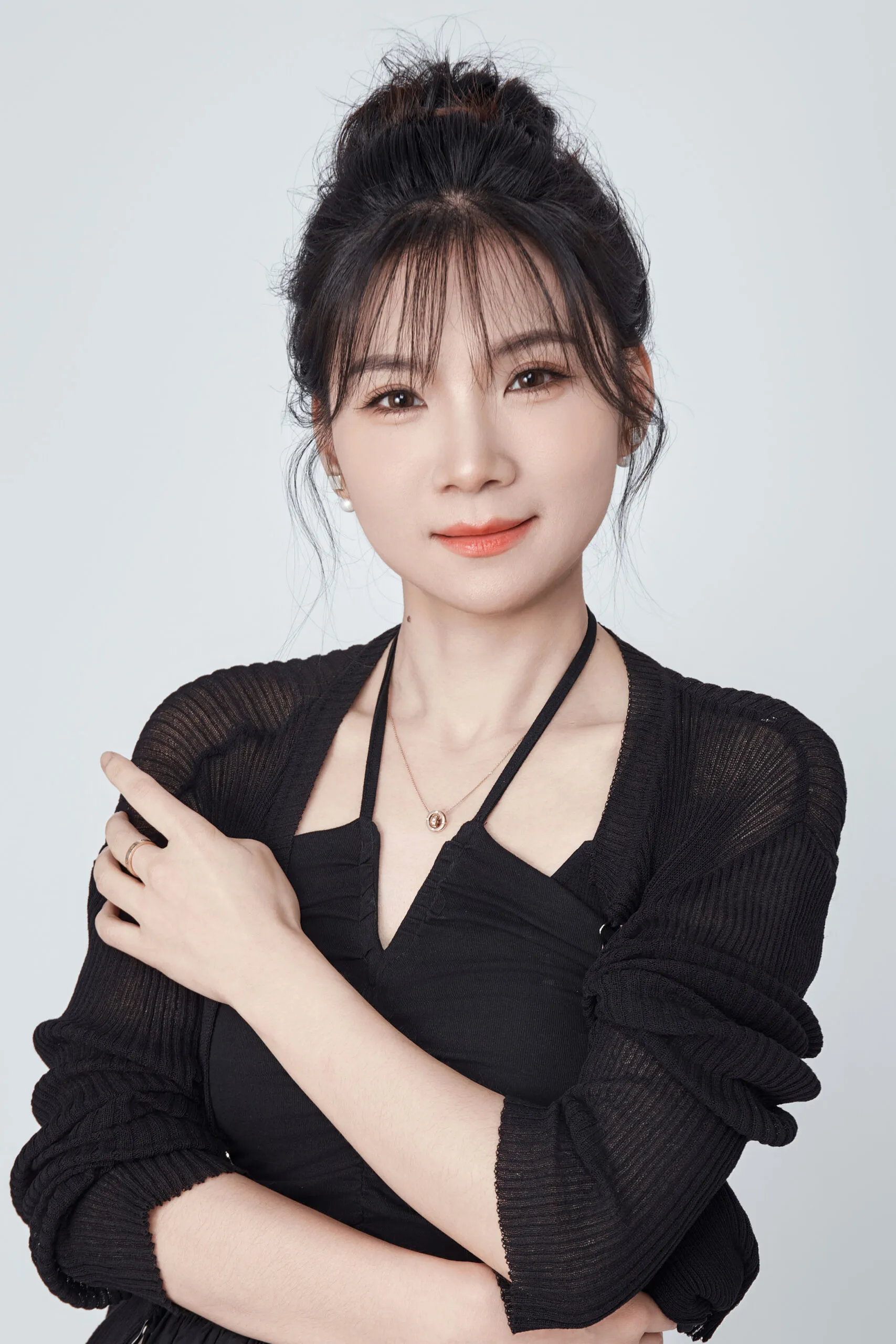Choosing the right highlighter brush1 feels confusing. Using the wrong one can waste product and ruin your makeup. I will show you exactly which brush to use and why.
There are six main types of highlighter brushes: fan, tapered, domed, small detail, duo-fiber, and flat angled. Each shape works best with a specific formula (powder, cream, liquid) and creates a different finish, from a sheer glow to a bright strobe effect.
When I first started working in a brush factory, I saw so many shapes and sizes. It was overwhelming. But over the years, I learned that only a few shapes do most of the work. Understanding these core types is the key to creating a product line that performs beautifully and sells well. It saves you from ordering unnecessary SKUs and helps your customers get the exact look they want. In this guide, I’ll walk you through everything you need to know, from a consumer’s perspective to a brand owner’s.
All highlighter brushes are made with the same synthetic fibers.False
Fiber material, coating, and density vary greatly. For example, fibers for cream highlighters need a slick coating to prevent clumping, which is different from fibers designed for powders.
The global cosmetic brush market is projected to reach USD 6.01 billion by 2034.True
According to market analysis, the industry is growing at a CAGR of around 4.9%, showing a strong and sustained demand for quality makeup tools.
What brush is best for powder highlighter?
Your powder highlighter2 looks like a chalky stripe. This makes your product look cheap and is frustrating for your customers. The right brush shape and density will give you a perfect, seamless glow every time.
For a sheer, subtle glow, use a fan brush3. For a stronger, more focused highlight with blended edges, use a narrow fluffy brush, like a tapered or domed shape. The density of the brush determines the intensity of the payoff.
Choosing the right brush for powder is all about controlling the amount of product you pick up and how it’s applied to the skin. A brush that is too dense will pack on too much shimmer, creating that dreaded stripe. A brush that is too flimsy won’t pick up enough product. The goal is to find the perfect balance for the finish your brand wants to be known for. I’ve helped hundreds of brands solve this exact problem by focusing on three key shapes.
For a Sheer Veil: The Fan Brush
The classic fan brush is perfect for a light dusting of powder. Its sparse fibers pick up just a little product and sweep it gently across the high points of the face. This creates a very subtle, believable glow. It’s also a great tool for sweeping away eyeshadow fallout without smudging your makeup. From a manufacturing standpoint, the key is controlling the spread. A fan brush underperforms if the tuft spread is more than 1.7 times the ferrule width. We specify this in the PO to ensure every brush in the batch performs the same.
For a Soft-Focus Glow: The Domed/Fluffy Brush
A fluffy, dome-shaped brush is a versatile choice. Its rounded head and airy fibers diffuse the powder for a soft-focus finish. It blends the edges of the highlight seamlessly, so you can’t tell where it begins or ends. This is a great, user-friendly option for retail sets because it’s hard to make a mistake with it. For these brushes, we use a lower density and a longer loft (the visible length of the fibers) to maximize that soft, blended effect.
For a Targeted Glow: The Tapered Brush
A tapered brush4 has a pointed tip that allows for more precise application. You can use the tip to apply highlighter to the cheekbones or brow bone, then use the fluffy sides to blend it out. It offers more intensity than a fan brush but still gives you great control. This is often the best-selling shape for brands because it works for both a natural or a more intense look.
Natural animal hair is always better for applying powder highlighter.False
Modern vegan synthetic fibers (like PBT/taklon) have been engineered to mimic the texture and pickup of natural hair. They are also more hygienic, easier to clean, and cruelty-free, which is now a requirement for many major retailers.
The Asia-Pacific region held over 36% of the cosmetic brush market share in 2023.True
This dominance is driven by K-Beauty and J-Beauty trends, which emphasize precision. This is why smaller, more detailed highlighter brushes are becoming more popular globally.
What brush is best for cream or liquid highlighter?
Cream and liquid highlighters can look patchy. They sometimes lift the foundation underneath, ruining a perfect base. This happens when you use a brush that absorbs the product or drags it across the skin.
A duo-fiber stippling brush is the best choice. Its mixed-length fibers apply cream and liquid formulas in a thin layer without disrupting your base makeup. A soft, densely packed synthetic tapered brush can also work well for a more targeted application.
Creams and liquids are tricky. They contain oils and emollients that can cause brush fibers to clump together. The wrong brush will either soak up all your product or smear it around. I remember a client who was developing a beautiful serum highlighter, but their initial brush samples made it look greasy and uneven. The problem wasn’t the formula; it was the brush fiber. We switched to a specific type of synthetic fiber, and the problem was solved.
The Duo-Fiber Brush for a "Glass Skin" Finish
This is my top recommendation for creams and liquids. It has two lengths of fibers. The longer fibers pick up and apply the product, while the shorter, denser fibers help buff and blend it into the skin without absorbing it. You use a light tapping or "stippling" motion. This builds up a beautiful, sheer radiance that looks like "glass skin." It’s the perfect tool for achieving that trendy, dewy look.
OEM Secret: The Right Fiber Matters Most
For cream and liquid products, the fiber material is more important than the brush shape. You need to specify slick, heat-stable PBT synthetic fibers5. I recommend asking your manufacturer for fibers with an anti-wicking coating. This prevents the brush from absorbing the oils in the formula. We always test our brush prototypes with emollient formulas at different temperatures (e.g., 23°C and 30°C) to make sure the pickup and laydown are consistent. This is a quality control step many factories skip.
You can use any synthetic brush for cream highlighter.False
No. Fibers without the right slickness or coating will clump and absorb the product, leading to a patchy application and wasted highlighter.
Duo-fiber brushes are designed to prevent lifting the foundation underneath.True
The stippling motion and mixed-length fibers gently press the product onto the skin rather than dragging it, which preserves the makeup layers underneath.
Fan brush vs tapered highlighter brush: which should my brand offer?
You have a limited budget for your first brush launch. Choosing the wrong SKU can lead to slow sales and dead inventory. You need to know which brush will give your brand the best return on investment.
Offer a tapered brush first. It is more versatile and delivers the stronger glow most consumers want. A fan brush is a great second option for a more subtle, editorial look or as part of a larger pro set.
This is one of the most common questions I get from brand founders. Both brushes are useful, but they serve different purposes and appeal to different customers. Your choice depends on your brand’s identity and your sales strategy. Are you targeting makeup artists who need utility tools, or everyday consumers who want one brush that does it all? Thinking about this will help you build a smarter product lineup.
The Tapered Brush: Your Bestselling All-Rounder
If you can only launch one brush, make it the tapered highlighter brush. It’s a true workhorse. It works well with powders, and a good synthetic version can also handle creams. The pointed tip offers precision, and the fluffy sides blend beautifully. It can create both a natural and an intense highlight, which makes it appealing to the widest range of customers. This is the safest and most profitable choice for a direct-to-consumer or Amazon brand.
The Fan Brush: Your Niche and Pro Tool
The fan brush is more of a specialty tool. It excels at creating a very sheer, diffused glow that looks amazing in photos. This makes it popular with makeup artists and for brands with a clean, "editorial" aesthetic. It’s also fantastic for sweeping away powder fallout. While it’s not as versatile as the tapered brush, it has a clear purpose. It’s a great addition to a professional brush set or as a unique item for a brand that wants to stand out.
How to Build Your Brush Set
For a new brand, I recommend launching a starter set with two highlighter brushes: a tapered brush and a fan brush. This covers both intense and sheer application for powders. For your next launch, you can introduce a duo-fiber brush6 specifically for creams and liquids. This creates an effective upsell strategy.
Fan brushes are outdated and no one uses them anymore.False
Fan brushes are still unmatched for creating a very sheer, natural powder glow and for cleanup. They are a staple in many professional makeup artist kits for their unique, delicate application.
Pairing a fan and tapered brush in a starter set provides customers with comprehensive options for powder application.True
This combination allows users to choose between a subtle, all-over glow (fan brush) and a more targeted, intense highlight (tapered brush), covering the most common highlighting techniques.
What size/shape do artists use for detail highlighting?
Highlighting small areas like the nose bridge, Cupid’s bow, or inner eye corner is messy with a large brush. A clumsy application looks unprofessional, especially in today’s world of high-definition cameras and user-generated content.
Artists use small, dense "packing" brushes, often called pencil brushes, or mini tapered brushes. These small shapes provide maximum control to place a precise pop of shine exactly where it’s needed without any mess.
The trend of "non-touring" and precise highlighting has made these small brushes essential. Think about all the TikTok and Instagram tutorials showing how to get a "snatched" nose or bright inner corners. These looks are impossible to create with a standard-sized highlighter brush. Offering a detail brush shows that your brand understands modern makeup techniques. This is especially important if you sell in the APAC market, where precision tools are in high demand.
The Small Packing or Pencil Brush
This brush usually has a small, tightly packed head with a rounded or slightly pointed tip. It’s designed to pick up a concentrated amount of product and "pack" it onto a tiny area. The fibers are dense and the loft is short, which gives the user complete control over placement. This is the perfect tool for that bright pop on the tip of the nose or the inner corner of the eye.
The Mini Tapered Brush
This is simply a miniature version of the standard tapered highlighter brush. It offers the same benefits—precision application from the tip and blending from the sides—but on a much smaller scale. It’s great for highlighting the brow bone or the Cupid’s bow, as it can lay down a precise line of light and soften the edges in one motion. For DTC brands, adding a mini precision brush to a kit is a smart move, as it directly targets trending search terms like "nose bridge highlight."
Your OEM/Private Label Checklist for Highlighter Brushes
To help you source with confidence, here is a quick guide. These are the details you should discuss with your manufacturer to ensure you get a high-quality, retail-ready product.
Key Specifications to Demand
- Fibers: Insist on high-grade, vegan synthetic fibers (PBT or Taklon). For creams, specify a slick coating.
- Density: Provide a target tuft weight with a small tolerance (e.g., ±5%) to ensure consistency across your entire order.
- Ferrule: Use rust-proof aluminum or brass. Confirm it meets low-lead compliance standards for your target markets (EU, US).
- Handle: Ask for sustainable options like FSC-certified wood or recycled materials.
- Compliance: Ensure your manufacturer can provide documentation for all claims (Vegan, Cruelty-Free) and that they use compliant materials like soy-based inks for printing.
Quick-Reference Guide to Highlighter Brush Types
| Brush Type | Best For (Formula/Finish) | Density Guidance | Recommended Fiber | Retail Claim Example |
|---|---|---|---|---|
| Fan Brush | Sheer powder glow, fallout cleanup | Low / Sparse | Fine PBT/Taklon | "For a subtle, ethereal veil of light." |
| Tapered Brush | Intense powder, controlled cream | Medium | Soft PBT/Taklon | "The perfect tool for a targeted, buildable glow." |
| Domed/Fluffy | Soft-focus powder blend | Low-Medium | Soft, long PBT | "Effortlessly diffuses for a natural, seamless finish." |
| Small Detail | Targeted shine (nose, brow bone) | High | Dense PBT | "For precise application and a pinpoint glow." |
| Duo-Fiber | Sheer cream/liquid, "glass skin" | Low / Mixed-Length | Coated PBT | "Builds a dewy, skin-like sheen without caking." |
| Flat Angled | Swept highlight (cheekbone, body) | Medium | Soft PBT | "Lays down color and blends edges for body highlighting." |
Conclusion
Choosing the right highlighter brush comes down to matching the shape and fiber to your formula. With these six core shapes, you can create any look and build a smart, profitable brush line.
References
-
Explore the best highlighter brushes to enhance your makeup application and achieve a flawless finish. ↩
-
Get tips on applying powder highlighter for a seamless and radiant glow. ↩
-
Discover the unique benefits of using a fan brush for a subtle glow and precise application. ↩
-
Learn how a tapered brush can provide precision and versatility for your highlighting needs. ↩
-
Learn why synthetic fibers are preferred for makeup brushes and their advantages over natural hair. ↩
-
Find out how duo-fiber brushes create a flawless finish for cream and liquid highlighters. ↩
